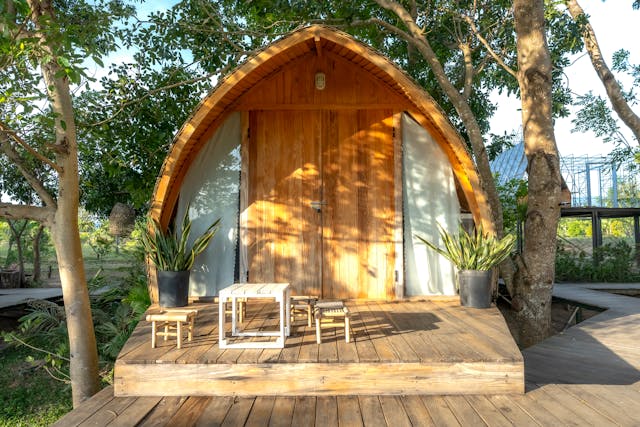Top Advantages of Choosing Wooden Garden Houses for Your Backyard
Adding a garden house is a quick way to expand usable space while freshening the look of any yard. Among the many construction materials available, timber continues to attract homeowners who appreciate its warm tones and time-tested strength. Beyond simple charm, wooden garden houses deliver a surprising mix of practical gains that other options rarely match. Understanding the benefits can help you make a decision on whether a wooden structure is the right enhancement for your outdoor area.
Natural Aesthetic Appeal
The first advantage is visual harmony. Wood blends seamlessly with greenery, flowers, and landscaping elements in ways plastic or metal cannot imitate. Natural grain patterns and mild color variations create texture that changes gently as light shifts throughout the day. Instead of standing apart from its surroundings, a wooden garden house feels like an organic extension of the yard. You can stain or paint the boards to complement existing fences or patio furniture, making the building feel purposely designed rather than dropped in at random. Over time, the surface can develop a gentle patina that adds to its character, ensuring the structure stays attractive without demanding artificial finishes.
Eco-Friendly Construction
Timber sourced from responsibly managed forests is widely regarded as one of the more environmentally conscious building materials. Trees absorb carbon dioxide while growing, locking that carbon into the wood even after harvest. When left untreated with harsh chemicals, wooden panels can eventually biodegrade, reducing long-term waste. Manufacturers often use energy-efficient processes to mill lumber compared with the high temperatures needed for steel production. Selecting wood from certified forests supports sustainable forestry practices, an important consideration for homeowners who want to lessen their ecological footprint without sacrificing strength.

Superior Insulation and Comfort
Wood is a natural insulator, helping regulate temperature inside the garden house throughout shifting seasons. In hot weather, the walls can moderate heat gain, keeping the interior cooler than thin-walled metal sheds that absorb sunlight. During cooler months, the same insulating properties help retain warmth, making the space comfortable for hobbies, reading, or remote work. This climate-stabilizing quality can reduce reliance on portable heaters or fans, conserving energy over the building’s lifetime. In addition, timber muffles exterior sounds better than sheet metal, creating a quieter hideaway for concentration or relaxation.
Versatility of Design and Use
A wooden garden house offers flexible sizing and layout possibilities. Panels can be cut and joined in countless configurations, from compact tool huts to spacious studio cabins. Additional features such as skylights, porches, or double doors are easier to incorporate with wood than with rigid pre-molded plastic shells. Once assembled, the structure can adapt to changing needs: today, a storage room, tomorrow, a playhouse, and later an art workshop. Interior walls can accept shelves, hooks, or electrical wiring without specialized fasteners, allowing effortless customization as hobbies or family activities change over time. This versatility grants homeowners long-term value from a single initial investment.
Ease of Assembly and Upkeep
Modern wooden garden house kits often arrive with pre-cut boards, labeled parts, and straightforward instructions. Many homeowners find they can complete assembly with basic tools over a weekend, eliminating the need for heavy machinery or welding equipment. If a panel becomes damaged, replacing an individual plank is usually simpler and less expensive than swapping an entire metal sheet. Routine maintenance involves occasional cleaning and the application of a protective stain or sealant, a task most people can handle without professional help. Thoughtful upkeep guards against moisture and pests, preserving structural integrity for many years.

Cost-Effectiveness and Long-Term Value
While initial prices vary, wooden garden houses frequently offer favorable cost-to-space ratios compared with masonry or elaborate steel frameworks. Timber’s insulating capacity can lower heating or cooling expenses, saving money in day-to-day use. Because wooden buildings are easier to repair and modify, unexpected changes rarely demand full replacements. The pleasant appearance of a well-kept wooden structure can also raise property appeal, supporting resale value should you decide to move. Altogether, these factors create a sensible financial picture that balances upfront spending against ongoing savings and potential appreciation.
Conclusion
Choosing a wooden garden house brings multiple advantages that reach beyond its classic look. From ecological considerations and energy efficiency to adaptive design and manageable upkeep, timber provides a comprehensive package of benefits for homeowners wanting both style and substance. Whether your goal is additional storage, a cozy retreat, or a creative studio, a wooden structure offers durability and comfort while blending gracefully with the outdoor setting. By weighing these advantages, you can make a confident decision—one that supplies years of enjoyment and functional space while preserving the natural charm of your backyard.…



 When embarking on a home construction project, one of the most crucial steps is planning and budgeting wisely. Start by clearly defining your goals and priorities for the new build. Consider factors like the size of the house, layout preferences, materials quality, and any special features you desire. Creating a detailed budget that outlines all projected costs will help you stay on track financially throughout the construction process.
When embarking on a home construction project, one of the most crucial steps is planning and budgeting wisely. Start by clearly defining your goals and priorities for the new build. Consider factors like the size of the house, layout preferences, materials quality, and any special features you desire. Creating a detailed budget that outlines all projected costs will help you stay on track financially throughout the construction process.

 Having a designated area for watching movies, playing video games, or relaxing is a great way to make your house feel like home. Invest in an entertainment center that provides enough space for your furniture and equipment. Take the time to shop around and get the best deals on these items, so you can start making your house feel like home. With these must-haves, you’ll be able to turn your place into a true home sweet home. If you are on a tight budget, consider what you can do with and without to avoid costly ventures.…
Having a designated area for watching movies, playing video games, or relaxing is a great way to make your house feel like home. Invest in an entertainment center that provides enough space for your furniture and equipment. Take the time to shop around and get the best deals on these items, so you can start making your house feel like home. With these must-haves, you’ll be able to turn your place into a true home sweet home. If you are on a tight budget, consider what you can do with and without to avoid costly ventures.…

 Many streaming services offer free trials. This is a great way to try a service before committing to it. Free trials typically last for one week or one month. You’ll have full access to the service’s content during this time. Once your trial is up, you can decide whether or not you want to continue using the service. If you do decide to keep it, be sure to cancel any other streaming services that you’re no longer using to avoid being charged for them.
Many streaming services offer free trials. This is a great way to try a service before committing to it. Free trials typically last for one week or one month. You’ll have full access to the service’s content during this time. Once your trial is up, you can decide whether or not you want to continue using the service. If you do decide to keep it, be sure to cancel any other streaming services that you’re no longer using to avoid being charged for them. If you love movies, you can save a lot of money by buying used DVDs and Blu-rays. You can often find great deals on films that are just a few years old. Best Buy, Walmart, and Amazon all sell used DVDs and Blu-rays. in addition, there are many great websites where you can buy used movies, such as Half.com and eBay. There are many great ways to save money on home entertainment.
If you love movies, you can save a lot of money by buying used DVDs and Blu-rays. You can often find great deals on films that are just a few years old. Best Buy, Walmart, and Amazon all sell used DVDs and Blu-rays. in addition, there are many great websites where you can buy used movies, such as Half.com and eBay. There are many great ways to save money on home entertainment.